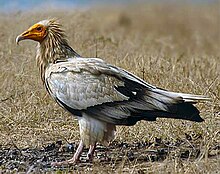Egyptian vulture
| Egyptian vulture | |
|---|---|
 |
|
| Adult N. p. ginginianus | |
| Scientific classification | |
| Kingdom: | Animalia |
| Phylum: | Chordata |
| Class: | Aves |
| Order: | Accipitriformes |
| Family: | Accipitridae |
| Genus: |
Neophron Savigny, 1809 |
| Species: | N. percnopterus |
| Binomial name | |
|
Neophron percnopterus (Linnaeus, 1758) |
|
 |
|
| Distribution of the three subspecies | |
| Measurements | |||
|---|---|---|---|
| Nominate | |||
| Culmen | 31–34 mm (1.2–1.3 in) | ||
| Wing | 470–536 mm (18.5–21.1 in) | ||
| 460–545 mm (18.1–21.5 in) | |||
| Tail | 220–251 mm (8.7–9.9 in) | ||
| 240–267 mm (9.4–10.5 in) | |||
| Tarsus | 75–87 mm (3.0–3.4 in) | ||
| Weight | 1,600–2,400 g (56.4–84.7 oz) | ||
| ginginianus | |||
| Wing | 393–490 mm (15.5–19.3 in) | ||
| 455–505 mm (17.9–19.9 in) | |||
| Tail | 228–251 mm (9.0–9.9 in) | ||
| Tarsus | 72–85 mm (2.8–3.3 in) | ||
| majorensis | |||
| Wing | 485–554 mm (19.1–21.8 in) | ||
| Tail | 240–285 mm (9.4–11.2 in) | ||
| Tarsus | 73.5–93 mm (2.9–3.7 in) | ||
| Weight | 1,900–2,850 g (67.0–100.5 oz) | ||
The Egyptian vulture (Neophron percnopterus), also called the white scavenger vulture or pharaoh's chicken, is a small Old World vulture and the only member of the genus Neophron. It is widely distributed; the Egyptian vulture is found from southwestern Europe and northern Africa to India. The contrasting underwing pattern and wedge-shaped tail make it distinctive in flight as it soars in thermals during the warmer parts of the day. Egyptian vultures feed mainly on carrion but are opportunistic and will prey on small mammals, birds, and reptiles. They also feed on the eggs of other birds, breaking larger ones by tossing a large pebble onto them. The use of tools is rare in birds and apart from the use of a pebble as a hammer, Egyptian vultures also use twigs to roll up wool for use in their nest. Egyptian vultures that breed in the temperate regions migrate south in winter while tropical populations are relatively sedentary. Populations of this species have declined in the 20th century and some island populations are endangered by hunting, accidental poisoning, and collision with power lines.
The Egyptian vulture was first formally described by the Swedish naturalist Carl Linnaeus in 1758 in the tenth edition of his Systema Naturae under the binomial name Vultur percnopterus. The current genus Neophron contains only a single species. A few prehistoric species from the Neogene period in North America placed in the genus Neophrontops (the name meaning "looks like Neophron") are believed to have been very similar to these vultures in lifestyle, but the genetic relationships are unclear. The genus Neophron is considered to represent the oldest branch within the evolutionary tree of vultures. Along with its nearest evolutionary relative, the lammergeier (Gypaetus barbatus), they are sometimes placed in a separate subfamily, the Gypaetinae.
...
Wikipedia

